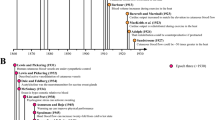Abstract
Marathon races are performed over a broad range of environmental conditions. Hyperthermia is a primary challenge for runners in temperate and warm weather, but hypothermia can be a concern during cool-wet or cold conditions. Body temperature during the marathon is a balance between metabolic heat production and exchange with the environment described by the heat balance equation. During exercise, core temperature is proportional to the metabolic rate and largely independent of a wide range of environmental conditions. In temperate or cool conditions, a large skin-to-ambient temperature gradient facilitates radiant and convective heat loss, and reduces skin blood flow requirements, which may explain the tolerance for high core temperature observed during marathons in cool conditions. However, in warmer environments, skin temperatures and sweating rates increase. In addition, greater skin blood flow is required for heat loss, magnifying thermoregulatory and circulatory strain. The combined challenge of exercise and environment associated with marathon running can substantially challenge the human thermoregulatory system.


Similar content being viewed by others
References
Cheuvront SN, Haynnes EM. Thermoreguladon and marathon running: biological and environmental influences. Sports Med 2001; 31 (10): 743–62
Sawka MN, Young A. Physiological systems and their responses to conditions of heat and cold. In: Tipton CM, editor. American College of Sports Medicine’s Advanced exercise physiology. Philadelphia (PA): Lippincott Williams and Wiltons, 2006: 535–63
Lind AR. Prediction of safe limits for prolonged occupational exposure to heat. Fed Proc 1973; 32: 1602–6
Maron MB, Wagner JA, Horvath SM. Thermoregulatory responses during competitive marathon running. J Appl Physiol 1977; 42: 909–14
Byrne C, Lee JK, Chew SA, et al. Continuous thermoregulatory responses to mass participation distance running in heat. Med Sci Sports Exerc 2006 May; 38 (5): 803–10
Gagge AP, Gonzalez RR. Mechanisms of heat exchange: biophysics and physiology. In: Fregly MJ, Blatteis CM, editors. Handbook of physiology: environmental physiology. Bethesda (MD): American Physiological Society, 1996: 45–84
Rowell LB. Human circulation: regulation during physical stress. New York: Oxford University Press, 1986
Nadel ER, Canrelli E, Roberts ML et al. Circulatory regulation during exercise in different ambient temperatures. J Appl Physiol 1979; 46: 430–7
Gonzalez-Alonso J, Mora-Rorlriguez R, Coyle EF. Stroke volume during exercise: interaction of environment and hydration. Am J Physiol Heart Circ Physiol 2000 Feb; 278 (2): H321–30
Martin DE. Climatic heat stress studies at the Atlanta 1996 Olympic stadium venue. Sport Med Train Rehabil 1996; 6: 249–67
Acknowledgements
The views, opinions and/or findings contained in this report are those of the authors and should not be construed as an official Department of the Army position, policy or decision unless so designated by other official documentation. The authors have indicated that they have no affiliation or financial interest in any organisation(s) that may have a direct interest in the subject matter of this article.
Author information
Authors and Affiliations
Corresponding author
Rights and permissions
About this article
Cite this article
Kenefick, R.W., Cheuvront, S.N. & Sawka, M.N. Thermoregulatory Function During the Marathon. Sports Med 37, 312–315 (2007). https://doi.org/10.2165/00007256-200737040-00010
Published:
Issue Date:
DOI: https://doi.org/10.2165/00007256-200737040-00010




